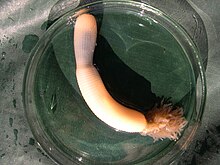Priapulid
| Priapulida Temporal range: Late Pennsylvanian–Recent(Priapulid-like burrows from Cambrian) |
|
|---|---|
 |
|
| Priapulus caudatus | |
| Scientific classification | |
| Kingdom: | Animalia |
| Clade: | Vinctiplicata |
| Phylum: |
Priapulida Théel, 1906 |
| Classes | |
Priapulida (priapulid worms or penis worms, from Gr. πριάπος, priāpos 'Priapus' + Lat. -ul-, diminutive) is a phylum of marine worms. The name of the phylum relates to the Greek god of fertility, because their general shape and their extensible spiny introvert (eversible proboscis) may recall the shape of a penis. They live in the mud (which they eat) and in comparatively shallow waters up to 90 metres (300 ft) deep. Some species show a remarkable tolerance for hydrogen sulfide and anoxia.
Together with Echiura and Sipuncula, they were once placed in the taxon Gephyrea, but consistent morphological and molecular evidence supports their belonging to Ecdysozoa, which also includes arthropods and nematodes. Fossil findings show that the mouth design of the ancient arthropod group Pambdelurion is identical with that of priapulids, indicating that their mouth is an original trait inherited from the last common ancestor of both priapulids and arthropods, even if modern arthropods no longer possess it. Among Ecdysozoa, their nearest relatives are Kinorhyncha and Loricifera, with which they constitute the Scalidophora clade named after the spines covering the introvert (scalids). They feed on slow-moving invertebrates, such as polychaete worms.
Priapulid-like fossils are known at least as far back as the Middle Cambrian. They were likely major predators of the Cambrian period. However, crown-group priapulids cannot be recognized until the Carboniferous. About 20 extant species of priapulid worms are known, half of them being of meiobenthic size.
Priapulids are cylindrical worm-like animals, ranging from 0.2–0.3 to 39 centimetres ( 0.08–0.12 to 15.35 in) long, with a median anterior mouth quite devoid of any armature or tentacles. The body is divided into a main trunk or abdomen and a somewhat swollen proboscis region ornamented with longitudinal ridges. The body is ringed and often has circles of spines, which are continued into the slightly protrusible pharynx. Some species may also have a tail or a pair of caudal appendages. The body has a chitinous cuticle that is moulted as the animal grows.
...
Wikipedia
